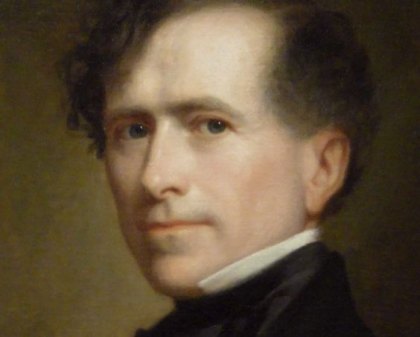New Hampshire's president: Franklin Pierce

You could be forgiven for drawing a blank when trying to remember Franklin Pierce. The 14th president of the United States, Pierce was from Hillsborough, New Hampshire, and sadly ranks among the bottom five presidents, according to the Sienna College Research Institute.
Another president, Harry S. Truman, summed up Pierce this way: “Pierce was the best looking president the White House ever had – but as president he ranks with [James] Buchanan and Calvin Coolidge.”
Here are the basics:
Birth: Pierce was born Nov. 23, 1804, to Anna Kendrick Pierce and Benjamin Pierce, an officer during the Revolutionary War who later became a state legislator and governor.
Education: He was educated at a brick schoolhouse in Hillsborough, according to The Complete Book of Presidents, By William A. DeGregorio and Sandra Lee Stuart, (Barricade Books; 2013). Pierce continued his studies at various schools and was admitted to Bowdoin College, where he befriended a fellow student, Nathaniel Hawthorne.
Marriage and family: In 1834, Pierce married 28-year-old Jane Appleton (1806-1863). Articles about the Pierces note that she found politics distasteful and he had a drinking problem. In addition, none of their children survived childhood The oldest, named for his father, died in infancy. Another child died at 4. The third son, Benjamin, was born 1841 and died in 1853, at age 11, in a train accident.
Before the White House: Pierce was a lawyer with political ambitions. While still in his mid-20s, he was elected to the New Hampshire legislature. In 1833 he was elected U.S. representative for New Hampshire. He became a U.S. senator (by vote of the New Hampshire legislature) in 1836. He was 32 at the time.
During the Mexican-American War (1846-48) Pierce served as a brigadier general, a position attained through political connections. It was an unhappy experience. Pierce’s leg was crushed when he fell from his horse, and the pain was so intense that he passed out. To make matters worse, some of his men started calling him “Fainting Frank,” according to the Miller Center of Public Affairs at the University of Virginia. (See Franklin Pierce: Life before the Presidency on the University of Virginia website.)
His opponent, a Whig, was Winfield Scott of New Jersey, a 6-foot-5-inch military man considered a national hero. Pierce won with 51 percent of the popular vote.
Both parties supported the Compromise of 1850 -- five laws passed in September 1850 dealing with slavery. As part of the compromise, territorial governments were formed in New Mexico and Utah. The slavery question was to be decided later, by popular sovereignty. While thought to avert a national crisis over slavery, deciding such an issue by popular sovereignty would prove problematic.
Domestic policy: The discontent with Pierce can be traced, in part, to his support of the Kansas-Nebraska Act of 1854.The act, sponsored by Illinois Sen. Stephen Douglas, “divided the land west of Missouri into two territories, Kansas and Nebraska,” recounts the National Archives website. “He argued for popular sovereignty, which would allow the settlers of the new territories to decide if slavery would be legal there. Antislavery supporters were outraged because, under the terms of the Missouri Compromise of 1820, slavery would have been outlawed in both territories.”
Pierce signed the act. With both pro-slavery and anti-slavery settlers in Kansas, violence soon erupted. (See John Brown: Hero or terrorist?) This set the stage for the Civil War.
Foreign policy: The 1853 Gadsden Purchase involved a $10 million purchase from Mexico of land for a southern transcontinental railroad. The deal was negotiated by the U.S. minister to Mexico, James Gadsden. As pointed out by DeGregorio in The Complete Book of Presidents, this land is now southernmost Arizona and New Mexico: “The acquisition completed the modern outline of the 48 contiguous states.”
But foreign policy also proved problematic for Pierce. He wished to annex Cuba in an attempt to extend the country’s southern reaches. Gathering in Ostend, Belgium, three U.S. ministers (one of whom was James Buchanan, a future president) drafted a document known as the Ostend Manifesto or the Ostend Doctrine. The Library of Congress website explains that the manifesto “urged the purchase or (if necessary) seizure of Cuba from Spain.”
The manifesto proved a problem, as critics charged that the acquisition of Cuba would create another slave state.
Politics in 1856: Instead of selecting Pierce again, the Democratic Party chose to nominate Buchanan, who was elected president.
Death: Oct. 8, 1869, in Concord, New Hampshire.
Trivia: Barbara Pierce Bush, wife of George H.W. Bush, and Pierce are distant relatives.
Sources:
- The American Presidency Project, University of California: Election of 1852.
- The Complete Book of Presidents, By William A. DeGregorio and Sandra Lee Stuart, (Barricade Books; 2013).
- Encyclopedia Britannica: Barbara Bush.
- Library of Congress: Compromise of 1850.
- Library of Congress: Democratic National Political Conventions, 1832-2008
- Library of Congress: Kansas-Nebraska Act.
- Library of Congress: Ostend Doctrine
- The Miller Center, University of Virginia: Franklin Pierce.
- National Archives: Kansas-Nebraska Act.
- National Archives: Compromise of 1850.
- PBS, The American Experience: Franklin Pierce.
- PBS, The Compromise of 1850 and the Fugitive Slave Act.
- Sienna College Research Institute: Presidential rankings.
- WhiteHouse.gov: Franklin Pierce.
Related:
If you would like to comment, give us a shout, or like us on Facebook and tell us what you think.

